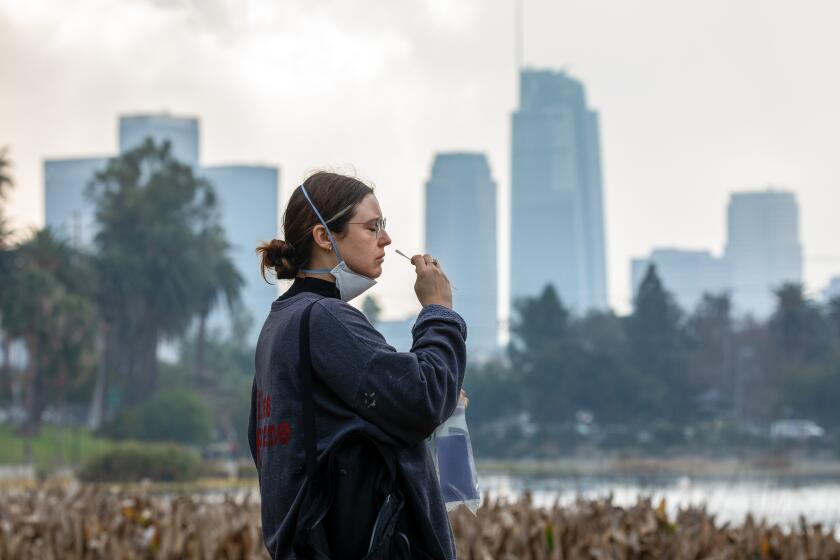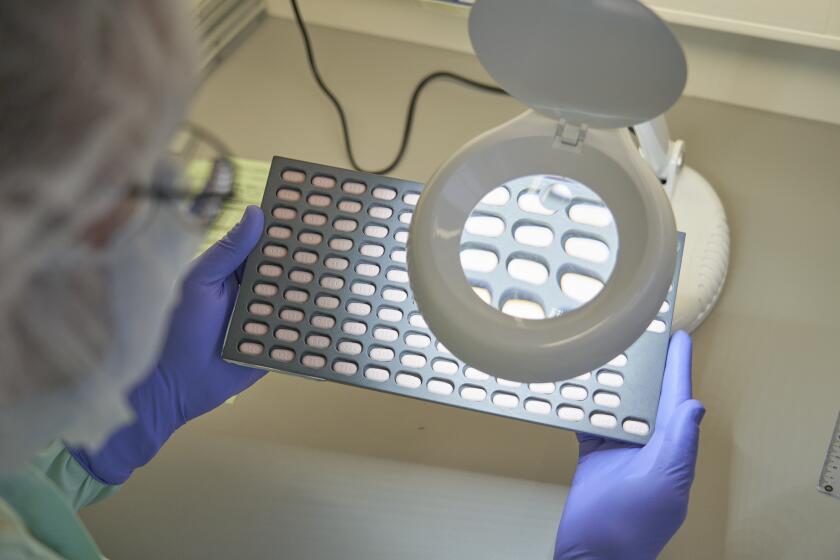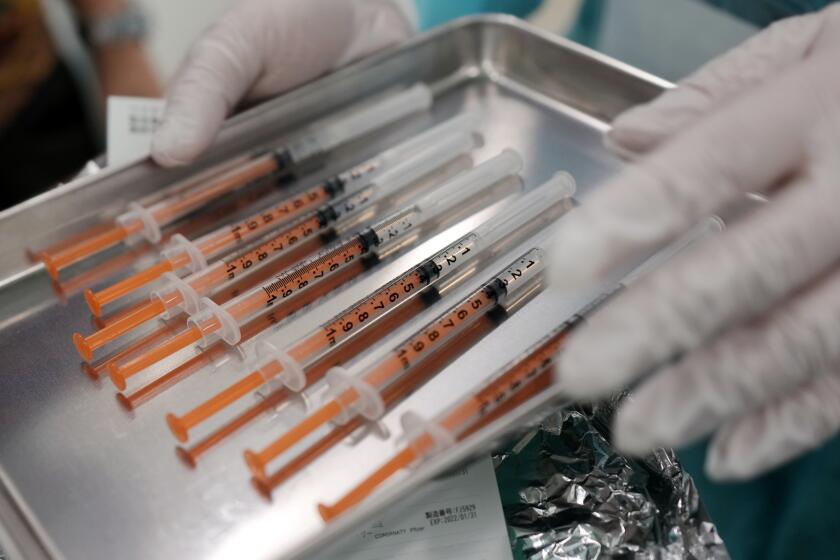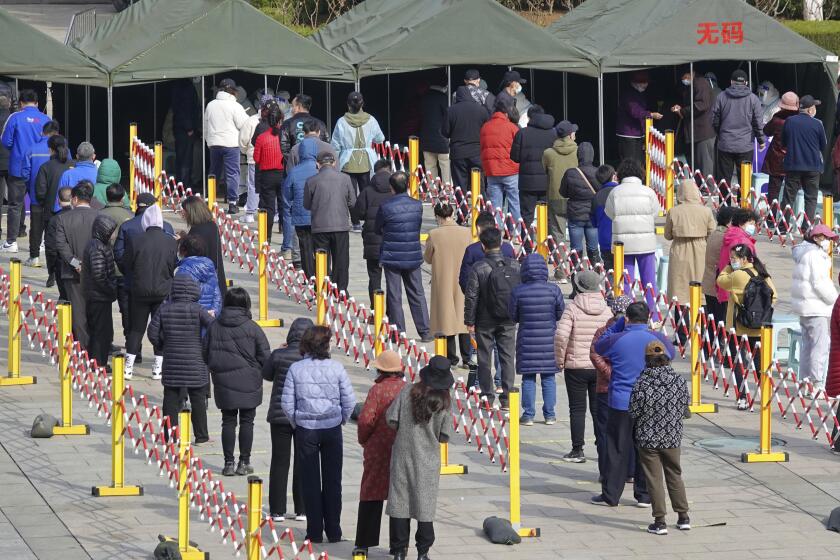Coronavirus cases are rising in Europe. Is it a warning for California?
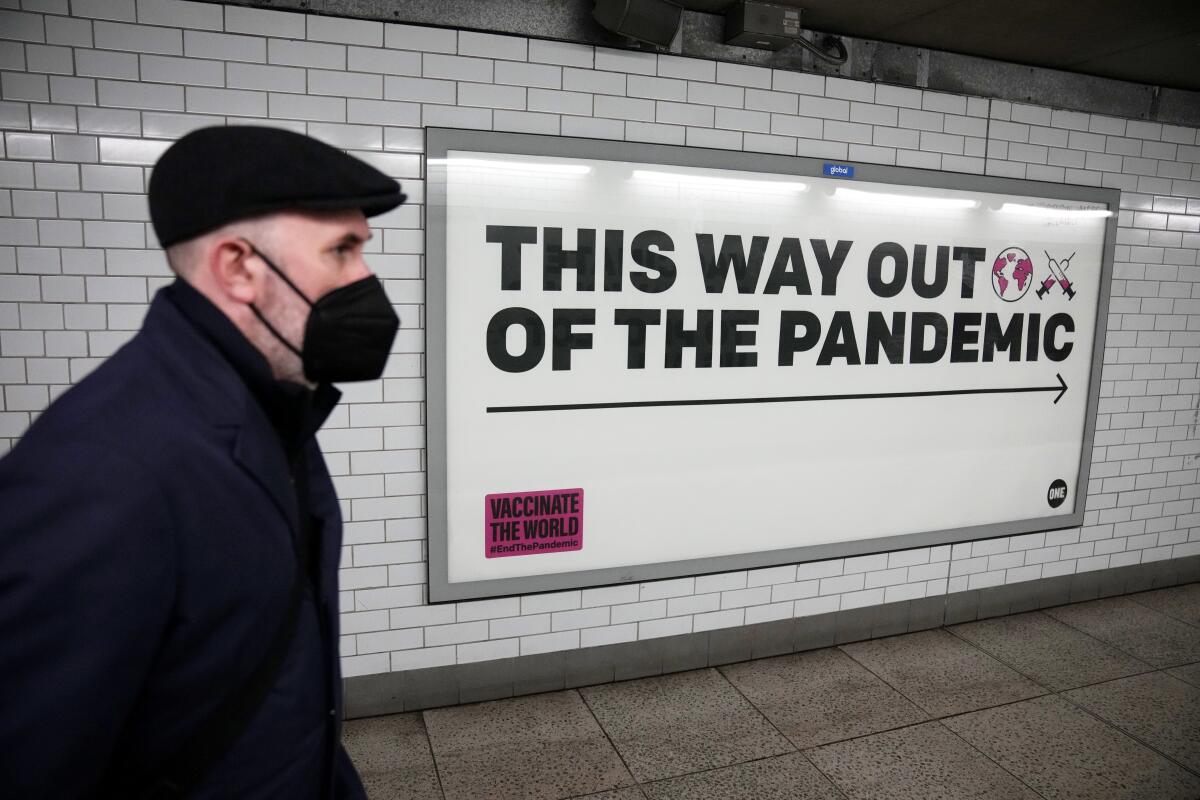
- Share via
Rising coronavirus cases in Europe are a potential warning sign that another pandemic wave is possible this spring in California and the U.S., experts say.
The recent increases documented in the United Kingdom and elsewhere in Europe are in contrast to the continued declines in California and the United States. But conditions across the pond have routinely been a harbinger of things to come stateside, and experts say a close watch is warranted.
“What happens in the U.K. and Europe doesn’t stay there,” Dr. Eric Topol, director of the Scripps Research Translational Institute in La Jolla, observed on Twitter this week.
During the last week of February, Britain was recording 355 coronavirus cases a week for every 100,000 residents. The most recently reported rate was 694, according to Johns Hopkins University. In the European Union, the rate has risen from 764 to 872.
“The next wave in Europe has begun,” Topol said, adding that some countries are not only seeing increases in infections, but new hospital admissions as well.
The U.S. case rate, on the other hand, has fallen from 145 to 68 during the same time. And California has mirrored wider national trends, with its case rate falling from 148 to 76. The U.S. Centers for Disease Control and Prevention considers a rate of at least 100 to be a high level of transmission.
‘Deltacron’ is a hybrid of Delta and Omicron. How worried should California be?
Topol attributed the rise in coronavirus cases in many European countries to relaxed pandemic restrictions, waning immunity and higher transmission attributable to BA.2, a sublineage of the Omicron variant that spreads even more readily than the conventional BA.1.
“There’s no clear or consistent pattern to determine which (or all) of these factors are driving it. No new variants have been implicated,” Topol tweeted.
Andy Slavitt, a former senior adviser to President Biden’s pandemic response team, noted Monday that based on trends in Europe, the U.S. could see a new rise in coronavirus cases this spring.
Slavitt wrote on Twitter that new growth in coronavirus cases in Britain and Germany are a result of BA.2. He expects the U.S. trends to follow Europe’s for two reasons: BA.2 spreads about 30% faster than the currently dominant BA.1 sublineage, and roughly one-third of wastewater sites tracked nationally as part of a pandemic early-warning system are showing increases in coronavirus detection.
“As we have seen throughout the pandemic, the U.S. [has] followed Europe by several weeks in our waves of cases. That may happen again here,” he said.
South Korea had its deadliest day yet of the pandemic on Tuesday, with 293 deaths reported in the latest 24 hours
Of 401 U.S. sewage sites with coronavirus sampling data available as of Tuesday, 145 had reported at least a 10% increase in detecting coronavirus genetic material over a recent 15-day period, according to the CDC’s wastewater surveillance website.
Sixty-two sites reported at least a 1,000% increase over the same timespan. Many of those are on the East Coast and in the Midwest, but one is in San Benito County.
A sewage plant in Contra Costa County, the San Francisco Bay Area’s third-most-populous, is reporting at least a doubling of coronavirus genetic material during that time, according to the CDC.
Plants in Southern California, meanwhile, are still currently reporting a decline.
In California, health officials have repeatedly warned that potential new surges or the emergence of some new coronavirus variant would not be a surprise.
“We do see other nations where we’re starting to see some cases rise, so it’s very important for everyone to continue to use all the preventive measures and layer up,” said Dr. Regina Chinsio-Kwong, Orange County’s health officer. “And that means getting fully vaccinated, getting boosted if you’re eligible, getting your additional dose if you’re immunocompromised and also [continuing] to wear a mask — especially if you have someone at home who is vulnerable, if you yourself are not vaccinated, if you have children who are not yet vaccinated or if you have someone in the home who is immunocompromised.”
L.A. County has launched a program that offers anti-COVID pills for free to infected people who get tested, or show test results, at select pharmacies.
While officials have recently lifted nearly every requirement for masking indoors while in public, they continue to strongly recommend the practice as an extra layer of protection against future surges. Federal officials have taken an even more relaxed posture, as the CDC no longer recommends universal masking in most of California.
“We know there’s going to be a next variant. We just don’t know if it’s going to be less serious or more serious, and we need to be prepared,” state epidemiologist Dr. Erica Pan said in a recent briefing to the California Medical Assn.
Pan said the state is seeing increased cases of BA.2. Some argue that BA.2 should be considered distinct from Omicron “because it’s so different” compared to other sublineages, Pan added. As of last week, cases of BA.2 were increasing but in the context of an overall decrease in coronavirus cases.
“There’s definitely data out there that BA.2 is more infectious, but not necessarily more severe. So that’s what we’re watching,” Pan said.
Between Feb. 13 and Feb. 19, BA.2 comprised 5% of analyzed coronavirus samples in L.A. County — more than double the prior week’s share, according to data released last week.
“While BA.2 is slowly increasing in the county, it still makes up a very small proportion of all sequenced cases,” Public Health Director Barbara Ferrer told reporters last week.
Virtually all the remaining coronavirus samples in L.A. County are either BA.1, or its descendant, BA.1.1, according to the data.
How the online wellness community pivoted from juice cleanses and special diets to embracing COVID-19 vaccine skepticism.
It remains to be seen how long the latest European uptick lasts, or what the ultimate consequences will be for the U.S.
Because so many people have either been boosted or recently infected, a wave fueled by BA.2 could result in “lots of cases, but an even lower portion of people hospitalized than [the] last wave,” Slavitt said.
During the peak of the Omicron surge, about 1.2% of L.A. County’s coronavirus cases required hospitalization, according to county data provided earlier this month. That’s significantly lower than the ratios seen at the height of last summer’s Delta wave, in which 5.6% of cases needed hospital care; or the 2020-21 winter wave, when the same was true for 5% of cases.
Still, significantly more people died in L.A. County’s Omicron-fueled wave than during the Delta wave, owing to Omicron’s ultra-contagiousness, which led to far more people being infected.
Given how easily Omicron spreads, officials have said getting a timely booster dose is essential to ensure residents are as protected as possible.
However, progress on that front has not been as quick as some would like. While almost three-quarters of eligible seniors have been boosted, the same is true for only about 64% of those ages 50 to 64 and a little more than half of younger adults. Only about a third of eligible 12- to 17-year-olds have gotten a booster, state health data show.
While 71% of Los Angeles County’s 10-plus million residents are considered fully vaccinated, only about 35% of all residents have received a booster dose, according to county data.
According to the most recent available state figures, unvaccinated Californians were five times more likely to get COVID-19, nine times more likely to be hospitalized and almost 17 times more likely to die from the disease than those who were fully vaccinated and boosted.
“The evidence remains compelling that reducing community transmission, hospitalizations and deaths and preventing, therefore, strain on our healthcare system is best accomplished if more residents are vaccinated and boosted,” Ferrer said.
Students and families across much of L.A. County got to choose whether to wear masks. The requirement remains in LAUSD as union negotiations continue.
All this, Slavitt added, means vaccinated people who have avoided Omicron infection but haven’t yet received a booster shot should get one, and children who haven’t been vaccinated and are eligible should get their shots, especially if they attend schools where masks are optional.
Additionally, for anyone who wants to avoid infection, masks remain highly protective, he said.
While cases, hospitalizations and deaths have been trending in a positive direction, “there are some dark-ish clouds on the horizon,” according to Dr. Robert Wachter, chair of UC San Francisco’s Department of Medicine.
There’s early evidence that unvaccinated people who survived an Omicron infection will have immunity to COVID-19, but they may be vulnerable to reinfection within a few months, Wachter wrote on Twitter. And “for those of us whose immunity comes from vaccination (including a booster), protection is also waning,” he added, and suggested that the time will come when a second booster shot will be recommended.
Pfizer is expected to request authorization this week for an additional booster shot for seniors, according to the Associated Press.
Vaccines and boosters proved highly effective against serious illness from Omicron. But what is also clear is that the defense afforded by vaccines wanes over time.
Low coronavirus case numbers may end up being misleading, Wachter added, noting that many people are now being diagnosed with rapid at-home tests, whose results are not systematically reported to the government.
Wachter said a more helpful number could be the rate of asymptomatic people who test positive, a figure that UC San Francisco tracks at its hospitals.
Last summer, as California fully reopened and before the Delta wave hit, just 1 in 500 asymptomatic people testing at UC San Francisco’s hospitals were found to be positive. Currently, 1 in 100 of those patients are testing positive.
That means that in a room of 20 people, there’s an 18% chance that someone has the virus, Wachter said.
“Not nothing, particularly if immunity’s waning and no one’s masked,” he said.
China has been locking down major cities to contain the outbreak, which by Western standards is small but tests Beijing’s zero-tolerance policy.
While Omicron has, for many, proved to cause milder illness than preceding variants, officials caution that a deluge of infections like that seen earlier this winter could still wreak havoc on healthcare systems.
Another less understood risk is long COVID, in which symptoms of illness can persist for months, if not longer.
Also concerning are reports suggesting that surviving a coronavirus infection will increase the risk of future cardiovascular events, such as heart attacks and strokes, by 50% to 70%, and that patients with prior COVID-19 suffered significant brain shrinkage, according to Wachter.
“While we don’t know whether this is associated with accelerated cognitive decline, it may be,” he added.
In a tweet Monday night, California’s public health director and health officer, Dr. Tomás Aragón, quoted from a commentary published in the journal Nature Reviews Microbiology, which warned it’s likely that the coronavirus will evolve in ways that may prove resistant to existing immunity — either through vaccinations or past infection — and could result in more severe illness.
“Omicron is the first [variant of concern] that is less virulent than other circulating strains and this has been enthusiastically interpreted to be a sign of the approaching end of the pandemic. Yet the lower severity of Omicron is nothing but a lucky coincidence,” said the commentary, written by scientists affiliated with the European Commission’s Joint Research Center and the University of Oxford.
More to Read
Sign up for Essential California
The most important California stories and recommendations in your inbox every morning.
You may occasionally receive promotional content from the Los Angeles Times.
